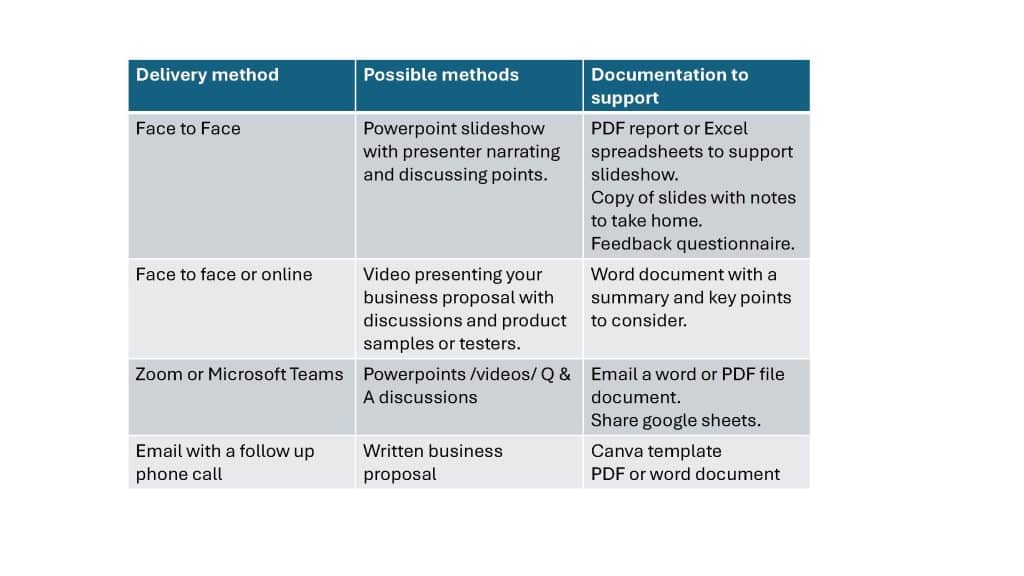Develop and present business proposals
About the Unit
Analyse information from a number of sources to determine the viability of your business idea.
Develop and present a professionally formatted and sequenced business proposal, outlining the viability of your proposed business.
Start with our Study guide BSBESB302
What does a business proposal look like?
Learning Outcomes
BSBESB302-Develop and Present Business Proposals
- Evaluate the viability of the business idea
- Manage risk associated with the business proposal
- Develop and present a professional business proposal outlining the viability of the business.

Click on the tabs below for Learning Resources
➡ Review Knowledge Question 1
Are you ready to be an Entrepreneur?
A clear understanding of what strengths you bring to your business and what time and commitment you can offer will assist you in determining the viability of your business. The more time and effort you can commit using your strengths will help you grow your business and minimise costs on labour.
➡ Review Knowledge Question 2.
The Business Feasibility Study
A Business Feasibility study will help you determine if your business idea is financially viable.
You need to establish:
- the details of your product or service you want to offer.
- if there is a demand and a sizeable market for your business idea.
- if the business can make a profit.
You can achieve this by conducting:
a) preliminary research, interviews, questionnaires and testing products.
b) primary and secondary research methods to gain valid, reliable and non-biased data to support your argument.
c) financial forecasts
Based on this research, you can determine whether it is worth your time and money to move forward.
Click on the links below to learn more about your skills:
➡Review Knowledge Question 3 & 4.
Factors Affecting Business Viability
What factors could affect your profits? Business viability is business profitability. Profit is the difference between sales and costs. Therefore, any factor that affects your sales or your costs will affect your profit.
Examples may include:
- Demand and supply:
- Are there enough people out there interested in what you are selling? (market size)
- Are you able to supply the quantity and quality expected by your customers? (customer feedback and sales analysis)
- Is there growth expected in your chosen sector?
- Do you have a Unique Selling Proposition or a niche that makes people want your product over others?
- How is consumer confidence and the economy looking at the moment and in the future?
- Do you control your costs?
- Is your pricing strategy in line with your competitors and your desired profit margins?
- Do you know what your customers want and need? (customer feedback)
- Do you have enough funds to stay afloat for the first 3 years?
- Do you communicate with your customers where they are looking?
Can you think of any other factors that will influence your sales or your costs? Consider the fact you are a sole trader. If you are sick or injured, this could seriously affect your business’s ability to deliver.
What about your skill levels and knowledge? If you are lacking, it may result in unhappy customers, which will affect your reviews and possibly decrease your sales.
Technology is always changing. Could technology make your business obsolete or could it help your business? Maybe it can save you time to do the stuff you love?
These are all points to consider when establishing whether your business idea is viable. Extensive research from numerous sources will help you establish this.
➡Refer to Knowledge Question 5
& Assessment 2 Task 6
How to Create a Business Proposal
A Business Proposal is often used to sell your business to gain investor interest or sell your product. The information you provide needs to cater to your audience and focus on the outcomes you want to achieve.
Step 1 : Who is your audience and what is the purpose of presenting this proposal?
Once you understand who your audience is and what you want to achieve, you can plan the information, the delivery option and language you want to use.
a) Information
When creating your presentation, you need to consider legislation, regulations or codes of practice that may influence what material you use. Consider Intellectual property, Copyright, Anti-discrimination, Privacy and Consumer Law. You may have others to comply with for your business.
Confidentiality- how much financial information should you share?
This depends on your audience and what you want to achieve. If you present to a Bank Manager, you will give thorough accounts and choose a delivery method that is more private, like an emailed report.
If you are pitching for investors, you will provide colourful graphs outlining their return on investment, amazing sales and profit ratios. You can always give them more details on request.
The information you choose to share is all based on the outcome you want to achieve. Do you need funds? Do you need sales? Remember your purpose.
For a more thorough understanding of how to write a business proposal, watch the following you tube videos.
The links below provide more information and examples:
➡️Refer to Knowledge question 5
Step 2: What delivery mode and format will I use?
When deciding on which option to use, you need to consider the following:
- How will you be delivering your proposal?
- Will it be in a one on one, face to face meeting?
- Will it be in writing and delivered via email?
- Are you required to present to a room full of people?
The choice you make will determine what method you use to present.
Click on the table below to see the options:
The videos and links below offer guidance and templates on how you can produce your proposal:
After the presentation of the business proposal
Once you have presented your proposal, you will gain feedback from your audience. Consider some methods you would use to record and store this feedback to reference for future use.
How would you document the feedback and where will you store it?
➡Review Knowledge Question 5
To complete Task 1 Click on the link below
To complete Task 2,3,4 & 5 click on the link below:
How to write a Business Proposal
You are required in Activity 6 to design a Business Proposal for your business.
You are to cover these areas in your proposal.
- Summary of your business idea/opportunity
- Potential business name (trading name)
- Clear description of the products/services being offered.
- What is your personal commitment to the business and your capability to offer the products/services to customers/clients?
- Who is your customer/s?
- What are the risks and impact to the business/products/services?
- What are the financial forecasts (e.g., cashflow, profit and loss) for the business, including expectations for financial returns on investments?
- Add a conclusion to your proposal about why you think your business idea will succeed (e.g., how you are different from your competitors, why is this product/service needed).
The assessment asks for your financial forecasts to be presented. ***Remember- a business proposal is a document that is to persuade or sell your business. Be careful of how much financial information you share. It also needs to look positive. Consider graphs that strongly communicate to the audience.***
Maybe make the audience a possible business investor or supplier who you would share this information with.
Target audience feedback
Provide proof that you have requested feedback. Share any feedback you received (if applicable).
➡Refer to Business Proposal tab for ideas on how to present and useful templates and websites
Here are two examples to help you with your proposal.
Document 4- Assessment 3- Business Plan Instructions
- Write your full name on the top of the first page “Participant name:”
- Attach a completed copy of your Small Business Plan as requested.
- Attach the completed parts of your Financial Plan that are requested.
Check off the Assessment Submission Checklist
This will ensure you have completed all tasks and paperwork correctly and we won’t need to return anything before marking.
News feed




